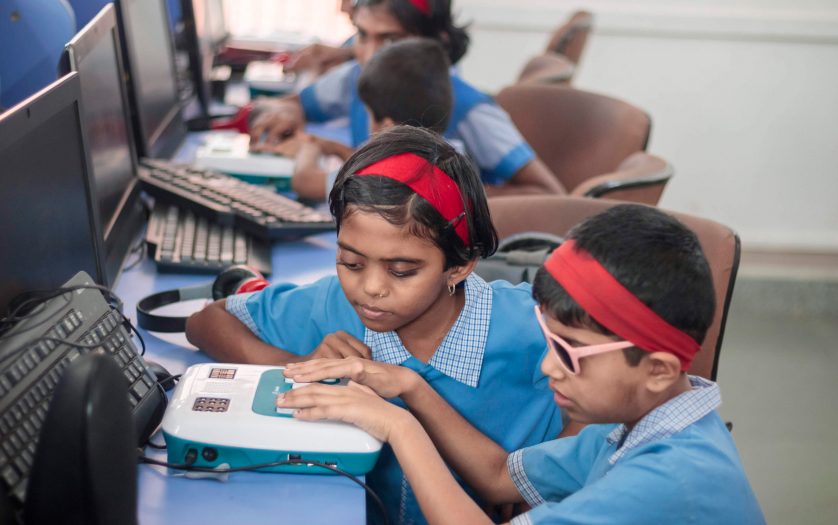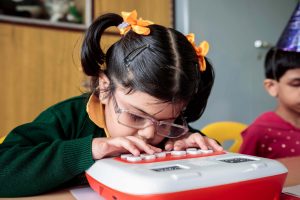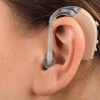Innovation in Braille self-learning could empower blind people in India

India’s Braille literacy rates are at an abysmal low of less than one percent. The shortage of trained educators is one of the greatest impediments in the spread and adaption of Braille as the script typically needs close engagement with the learner. The fewer the teachers, the harder it is for a visually impaired child to get the attention they need for an education truly beneficial to them. Furthermore, the modes of teaching and learning Braille have remained surprisingly unchanged for several decades. Annie, Thinkerbell Labs’ innovation in Braille self-learning, hopes to change the status quo.
The idea
Annie is designed to leverage technology to empower the learner to engage with Braille learning materials in five languages – English, Hindi, Marathi, Telugu, and Kannada – on their own, without the need for constant attention from a teacher. It is aimed to be an effective self-learning tool for reading, writing, and typing in Braille that allows learners to take their time with their lessons and practice until they’re satisfied with their work.
How does it work?

The device consists of two Braille displays for learners to read their lessons and play the gamified exercises on – a Large Braille Display, whose two cells have larger-than-usual dots, to help beginners easily read the script, and a Standard Braille Display, consisting of a row of six standard-sized Braille cells. There is a standard Brailler keyboard consisting of six keys (corresponding to each of the dots in a Braille cell) to learn typing on, a Braille slate that can be used with a standard stylus to learn writing on, and navigational keys for device manipulation. Furthermore, the device has speakers and a headphone jack for the learner to absorb the auditory elements of Annie, such as in-exercise instructions. Annie also closes the long and arduous feedback loop on exercises by allowing children to learn from and practice on the same device, providing instantaneous feedback.
Annie’s learning experience itself has prioritized learner retention as well as sustained engagement with Annie’s contents, be it from the software, content, or hardware perspective. This was trialed in collaboration with LV Prasad Eye Institute at Hyderabad. Annie’s content draws on the Royal National Institute of Blind People’s Hands-On, an introductory Braille reading scheme that is widely known and well-regarded, along with the designing team’s experiences learning Braille, as well as collective knowledge from the development of Annie.
Annie’s interactive pedagogy is established based on two aspects. First, that Annie is, after all, meant to help children, who like to play and learn from their surroundings, compete with their peers, and can get frustrated in the mundanity of a classroom. Secondly, that these visually impaired children’s learning is limited not by their disabilities, but by the conditions of their education, and the often outmoded forms of engagement with Braille – engagement that sighted children often have ready access to. Annie’s gamified and interactive lessons guide learners to consistently practice and improve their Braille skills through touch and sound.
Integrating Annie into the classroom experience has been essential to establishing an effective learning environment for both learners and teachers. This led to the conceptualization of Annie Smart Classes – multiple Annies set up in internet-enabled classrooms that could be supervised by teachers, and where learners could make the most of the collaborative and competitive learning materials on Annie. To empower teachers to track their students’ performance, plan their lessons, and so break the barrier of teachers needing to pay individual attention to students, the Annie ecosystem also consists of Helios, a digital suite to work in tandem with Annie. This also allowed for teachers, parents, and administrators – many of whom might not know Braille themselves – to understand the learning journey of the children through a shared platform, and create an ecosystemic approach to Braille learning in the smart class.
Impact
India’s first Annie Smart Class, and Thinkerbell Labs’ first deployment of the Annie ecosystem, was set up in June 2018 with 20 Annies at the Rajyakrit Netrahin Madhya Vidyalaya, a blind school in Ranchi, Jharkhand. The Ranchi Annie Smart Class, or ASC, was praised as an innovative means to Braille learning, and a benchmark for the country. The Indian Prime Minister Narendra Modi has praised the innovation of the Annie Smart Class in Ranchi. NITI Aayog and the National Institute for the Empowerment of Persons with Visual Disabilities in Dehradun recommend that state governments all over India take advantage of Annie’s capabilities to improve Braille literacy for visually impaired children.
Thinkerbell Labs today has set up 20 Annie Smart Classes across India, and partnered to have Annies at inclusive schools across the world. Annie has helped hundreds of visually impaired children in special and inclusive schools across the world, from India to the UAE to the UK, learn Braille reading, writing, and typing through interactive lessons in 5 languages across Grade 1 and Grade 2 Braille. Hundreds of students have logged thousands of hours of learning and multiplayer games in the classroom.







